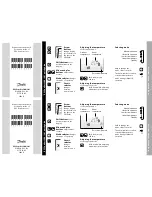
12
EX II Serial Controllers Reference Guide
3M Touch Systems Proprietary Information
Table 1 COM Cable for EX II 17xxSC and 77xxSC Controller
PC Side (9-Pin D)
Wire
Controller Side (7-Pin Molex)
Pin
RS-232 Assigned
Jumpered to:
Color
Pin
Description
1
Data Carrier Detect
(DCD)
4 and 6 DTR and DSR
⎯
None
2
Receive Data (RXD)
Brown 2
Transmit Data (TXD)
3
Transmit Data (TXD)
Red
3
Receive Data (RXD)
4
Data Terminal Ready
(DTR)
1 and 6 DCD and DSR
⎯
None
5
Signal Ground
Blue
5
Power supply ground
6
Data Set Ready (DSR)
1 and 4 DCD and DTR
⎯
None
7
Request to Send (RTS)
Black
1
Request to Send (RTS)
8
Clear to Send (CTS)
Green
4
Clear to Send (CTS)
9
Not Used
Do not ground
Sleeve
White
6
DC power jack (+5 VDC)
Pin
⎯
7
Cable shield connected to
ground. DC power jack ground
Shell
⎯
7
Chassis (earth) ground
Mounting the Controller
The uncased controller is mounted internally. Choose a convenient spot away from high-
voltage, high power cables and electronics. Use 4-40 metal screws to mount the
controller using the two diagonal mounting holes in the board. The controller is mounted
in line with the touch screen cable exit point to minimize cable flexing. The controller is
mounted behind or on the side of the display on stand offs to allow room for the touch
screen cable connector. Refer to Figure 1 for more details on controller mounting.
Supplying Power to the Controller
You must supply the EX II controller with power. You can use internal power (that is, tap
power from inside the monitor or PC) or external power.
However you supply power, the source must deliver 85 mA typical (110 mA maximum),
with a maximum ripple and noise of 50mV peak-to-peak.
CAUTION
To avoid possible damage to the controller,
you must provide a path for electrostatic
discharge. The controller-mounting hole near the touch screen connector should be
used to connect to chassis safety ground and must be attached by the shortest possible
route to a good earth return (chassis) in all applications.
You can supply power to the ClearTek II controller using any of the following methods.
The voltage input can vary from +5VDC to +12VDC. Exact specifications can be found
in the appendices.













































